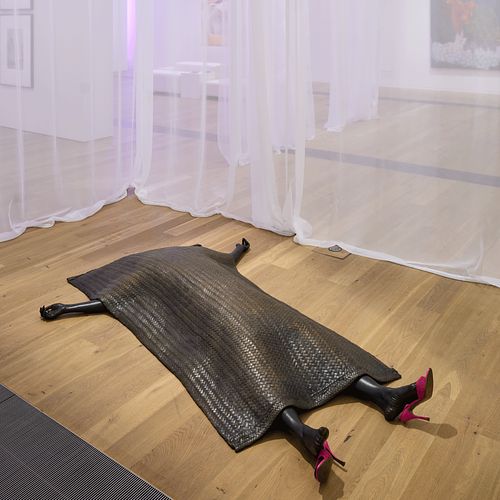AUDIO
Wangechi Mutu
Wangechi Mutu explores the diverse interrelationships between human beings, nature, and culture. Her collage-like paintings and bronze sculptures often depict hybrid creatures—somewhere between human, animal, and plant. Many of these figures remind us of fairy tales, myths, or religious narratives, but Mutu uses them to create something completely her own: new images that seem both familiar and strange at the same time.
Growing up in a Catholic community in Kenya, Mutu developed an early interest in the imagery of African diaspora religions. In her art, these influences merge with elements from pop culture, fashion, and nature. She focuses especially on the relationship between humans and the environment. The artist emphasizes the interconnectedness of all living things, and that we should not value any one species above any other.
In Subterranea Flayed Cow, Mutu explores the underground, hidden power of female identity and nature. She transforms the cow as a symbol and moves it into a hybrid, almost mythical realm. In this piece, Mutu combines themes like colonial history, environmental destruction, and consumerism with feminist spirituality.
Many of her works address social and political issues, often encoded in poetic, sometimes even unsettling images like the sculpture Shavasana II. It depicts a woman lying on her back. Her posture recalls the yoga position that gives the work its title, a pose of rest and contemplation. Here, however, we do not see only relaxation. A woven mat covers the woman’s body, leaving only her hands and feet visible at the ends of her outstretched arms and legs. Her elegant shoes are half off her feet, and they appear to have been placed there almost carelessly. Her entire posture remains ambiguous and thus fraught with tension: Is she in a state of deep relaxation, or has she been the victim of an assault? Is she asleep, or even dead?
The themes of violence, resistance, and healing appear repeatedly in Mutu’s work. Many of her sculptures and collages include figures that transcend boundaries: they resist clear categorization, instead representing change, resilience, and new possibilities.
Mutu’s works invite us to reflect on our own relationship with the world: What does it mean to be connected—to other people, to animals, to plants? And how can new images help us question old ideas?
Growing up in a Catholic community in Kenya, Mutu developed an early interest in the imagery of African diaspora religions. In her art, these influences merge with elements from pop culture, fashion, and nature. She focuses especially on the relationship between humans and the environment. The artist emphasizes the interconnectedness of all living things, and that we should not value any one species above any other.
In Subterranea Flayed Cow, Mutu explores the underground, hidden power of female identity and nature. She transforms the cow as a symbol and moves it into a hybrid, almost mythical realm. In this piece, Mutu combines themes like colonial history, environmental destruction, and consumerism with feminist spirituality.
Many of her works address social and political issues, often encoded in poetic, sometimes even unsettling images like the sculpture Shavasana II. It depicts a woman lying on her back. Her posture recalls the yoga position that gives the work its title, a pose of rest and contemplation. Here, however, we do not see only relaxation. A woven mat covers the woman’s body, leaving only her hands and feet visible at the ends of her outstretched arms and legs. Her elegant shoes are half off her feet, and they appear to have been placed there almost carelessly. Her entire posture remains ambiguous and thus fraught with tension: Is she in a state of deep relaxation, or has she been the victim of an assault? Is she asleep, or even dead?
The themes of violence, resistance, and healing appear repeatedly in Mutu’s work. Many of her sculptures and collages include figures that transcend boundaries: they resist clear categorization, instead representing change, resilience, and new possibilities.
Mutu’s works invite us to reflect on our own relationship with the world: What does it mean to be connected—to other people, to animals, to plants? And how can new images help us question old ideas?
